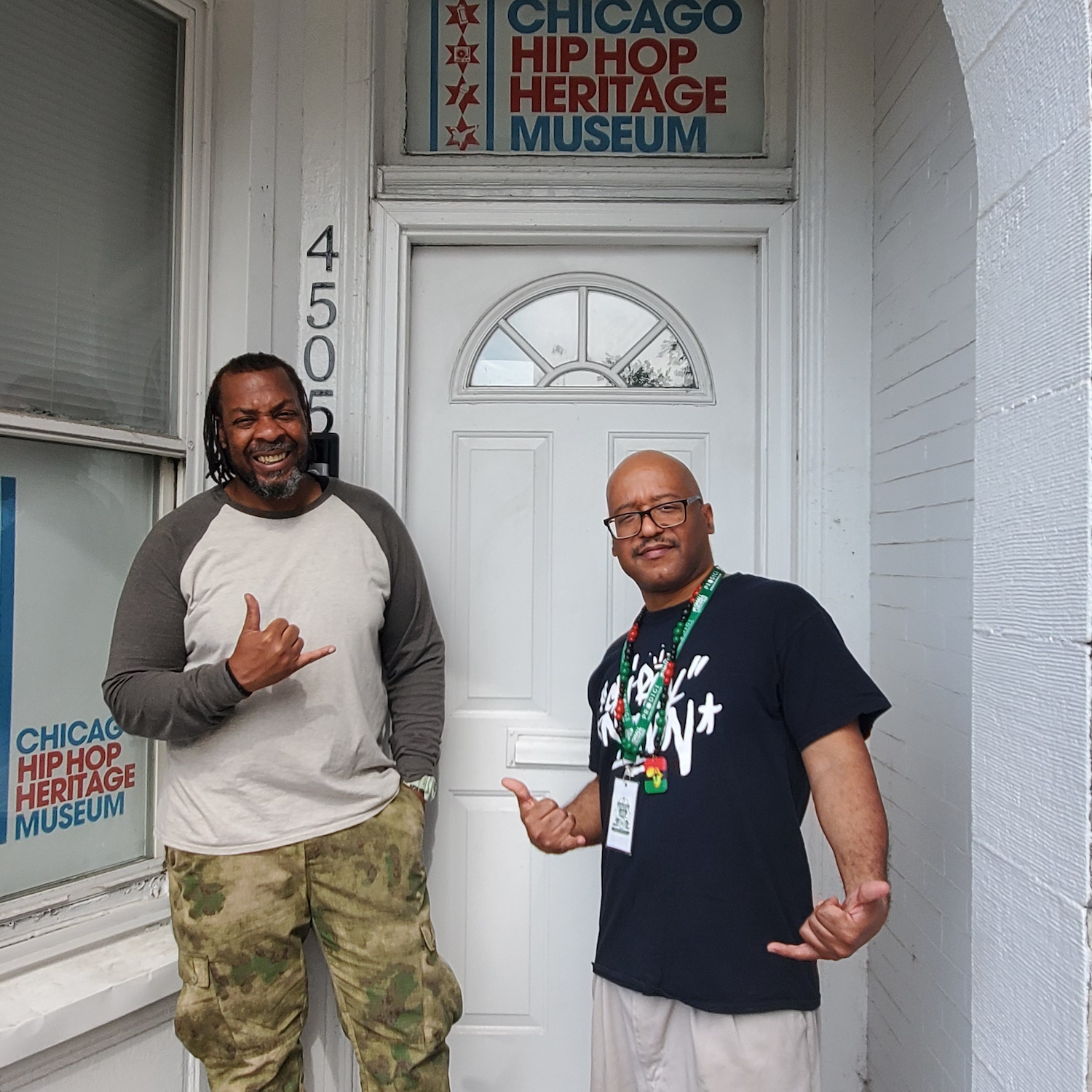We’re gonna meet a coupla old school dudes. Darrell “Artistic” Roberts, a graffiti artist, and Carrico “Kingdom Rock” Sanders, a rapper, are both 51. They’re two of the founders, curators and tour guides of the Chicago Hip Hop Heritage Museum, which occupies an apartment in a greystone at 4505 S. Indiana Ave., in the Grand Boulevard neighborhood. The museum is easy to miss on this residential block: there’s just a red, white and blue sign over the door, and another in a window, as modest as a school pride placard, or an advertisement for an aldermanic candidate.
So let’s go through the door. It’s more colorful inside. In the front hallway is a timeline of Chicago hip hop in the 1980s, the decade when Artistic and Kingdom Rock came on the scene. A framed poster for every year. In 1980, we learn, “Point Blank Sapp Supreme an emcee from the west side begins to write his own rhymes then later forms the group Raw Material” and “Graffiti writer WARP starts writing in Chicago from Cabrini Green Housing Projects.”
Really, though, says Artistic, Chicago’s contribution to hip hop goes back even further than that — all the way to Soul Train, which former Chicago police officer Don Cornelius first hosted on WCIU in 1970. The show made Chicago the birthplace of hip hop. Don didn’t really like rap, but hip hop goes a lot deeper than music — it’s a lifestyle that also encompasses art, dance, and fashion. As Kingdom Come puts it, “rap is something you do; hip hop is something you live.” A lot of that lifestyle first showed up on Soul Train.
“In Chicago, we keep it real,” Artistic says. “We put emphasis on style. We watched Soul Train because of the music, the fashion and the dance. I never knew where the Soul Train line came from until I heard Don Cornelius say they used to do this very concept in the backyards of events here in Chicago. And he just took that to California when he went there.”
“Hip hop is just the name that New York put on what it saw on Soul Train,” says Kingdom Come.
Artistic grew up in Roseland, Kingdom Come in Ida B. Wells Homes. (Brian Gorman, the other co-founder, publishes Chicago Community Activism Magazine.) They met in high school, at Dunbar. In the early 1990s, Kingdom Come was part of a collective called Ill State Assassins. Back then, there was East Coast rap and West Coast rap, but record labels didn’t think the Third Coast could rap. Chicago meant house music. So the Assassins put out music on their own labels, advertising it in The Source. Kingdom Come has preserved and displayed plenty of artifacts from those days. Flyers for shows at the Blue Gargoyle in Hyde Park. (“Be There Or Be A SUCKER!!!”) A poster for Common Sense’s 1992 album release party at the Vic, before he dropped the Sense and just became Common. A group photo of Chicago rappers at a pick-up basketball game, with Kanye West standing in the background, a no-name kid, long before Noname.
Twista was the first rapper to break out of Chicago, signing a multi-million dollar deal with Atlantic Records. Common broke around the same time. They were pioneers of the Chicago school of socially conscious hip hop, an alternative to the gangsta rap of the era. For that, Kingdom Come is proud of his city, and his scene.
“We’re equally responsible for holding hip hop down,” he says. “New York wasn’t even doing hip hop. Most of the artists that was coming out of New York was selling dope and killing. That’s what they was rapping about, but if you look at our hip hop artists — Lupe Fiasco, Vic Mensa, all the way down to Kanye — none of these guys are gangsta rappers. You can’t even call Twista gangsta. Common, Kids These Days, Chance the Rapper, none of these guys are gangstas. So we’ve been holding hip hop down in its rarest essence here, even though we still had the Drill on that side, doin’ what they’re doin.’”
Drill music, whose lyrics are inspired by gang life, is currently Chicago’s most celebrated hip hop sound. It’s not much celebrated at the Hip Hop Heritage Museum. These guys are old school, remember? Chief Keef and Lil Durk can’t be found on a mural of album covers in a second-floor bedroom. Artistic is not a Drill fan — “it’s so negative” — but the music demonstrates that the city is capable of producing multiple hip hop genres.
“Chicago is the type of city that doesn’t like to be contained,” he says. “Hip hop doesn’t like to be contained. It’s just like you put a seed in a box, right? Water it some, it starts growing. When you put a top on it, you’re containing it, but now you put the seed in the dirt, it’s open to the world. No telling how big it could be. That’s what hip hop is. That’s why you’ll get these branches, other styles like Drill. Now personally, I don’t like that type of style. But those guys do. You can’t just erase it. No matter how bad you dislike it or not, it’s still a part of it. Styles continue to grow.”
The Chicago Hip Hop Heritage Museum is not open all day, every day, like the Museum of Science and Industry. These guys have other shit to do. They only opened their museum a year ago. The best way to see it is to make an appointment through their Facebook page, or their website. There’s no charge for admission, but they take donations. July is Chicago Hip Hop Heritage Month, according to a 2003 act of the City Council, so this is the perfect time to visit. The proclamation is on display, right inside the door.
Related Content



